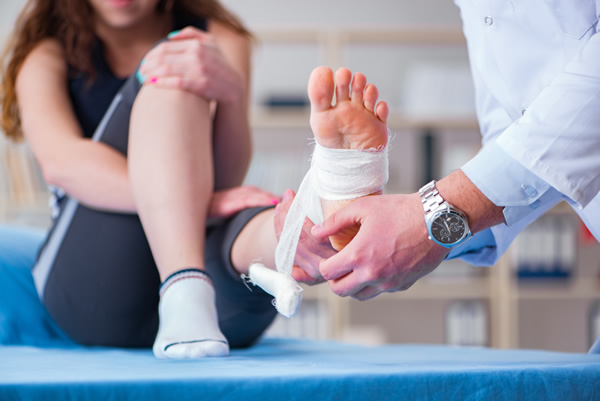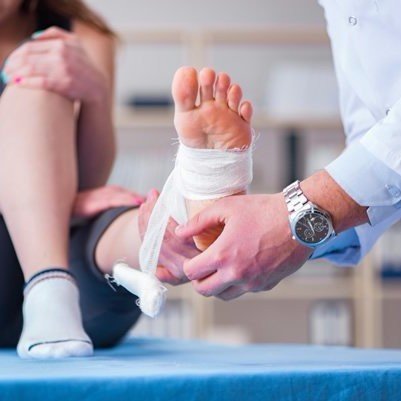Your Idaho Falls & Rexburg Foot & Ankle Specialists

Sports Injuries
Our Foot and Ankle Services
Many sports are hard on the feet because of quick repetitive movements, constricting footwear, and/or increased exposure to injury or trauma.

Aerobics Injuries to the Foot and Ankle
Impact forces from aerobics can reach up to six times the force of gravity, which is transmitted to each of the 26 bones in the foot. That is why proper shoes are crucial to successful, injury-free aerobics. Shoes should provide sufficient cushioning and shock absorption to compensate for pressure on the foot many times greater than found in walking. They must also have good medial-lateral stability.
Running & Track Injuries to the Foot and Ankle
Whether an athlete is a recreational, competitive or elite runner, foot and ankle health is essential for optimal performance. Runners are susceptible to overuse injuries, including heel pain (plantar fasciitis), Achilles tendonitis, sesamoiditis, stress fractures, posterior tibial tendonitis (or PTTD) and calcaneal apophysitis in children and adolescents.
Evaluation by a foot and ankle surgeon will help the athlete determine the underlying cause of pain and the best course of treatment. Custom orthotic devices are often used for treatment of these conditions.

Aerobics Injuries to the Foot and Ankle
Impact forces from aerobics can reach up to six times the force of gravity, which is transmitted to each of the 26 bones in the foot. That is why proper shoes are crucial to successful, injury-free aerobics. Shoes should provide sufficient cushioning and shock absorption to compensate for pressure on the foot many times greater than found in walking. They must also have good medial-lateral stability.
Soccer Injuries to the Foot or Ankle
Soccer is hard on the feet! Injuries to the foot and ankle can occur from running and side-to-side cutting, sliding or tackling and from striking the ball or another player with the foot. Soccer players should be aware of the following risks:
- Inversion ankle sprains can damage the ankle ligaments and can also be associated with peroneal tendon injuries and fractures.
- Ankle fractures, metatarsal fractures and Lisfranc fractures can sideline athletes and sometimes require surgery.
- Contusions and bone bruises may also result from high impact, such as in slide tackling.
- Overuse and excessive training can lead to heel pain (plantar fasciitis), Achilles tendonitis, sesamoiditis, stress fractures, posterior tibial tendonitis (or PTTD) and calcaneal apophysitis in children and adolescents.
Running and Track Injuries to the Foot or Ankle
Whether an athlete is a recreational, competitive or elite runner, foot and ankle health is essential for optimal performance. Runners are susceptible to overuse injuries, including heel pain (plantar fasciitis), Achilles tendonitis, sesamoiditis, stress fractures, posterior tibial tendonitis (or PTTD) and calcaneal apophysitis in children and adolescents.
Football Injuries to the Foot or Ankle
Football players can receive injuries to the foot and ankle due to running, side-to-side cutting or from direct trauma, such as from another player during a tackle. They should be aware of the following risks:
- Inversion ankle sprains can damage the ankle ligaments and can also be associated with peroneal tendon injuries and fractures.
- Ankle fractures, metatarsal fractures, Lisfranc fractures and turf toe can sideline athletes and sometimes require surgery.
- Contusions and bone bruises may also result from high impact during tackling.
- Overuse and excessive training can lead to heel pain (plantar fasciitis), Achilles tendonitis, sesamoiditis, stress fractures, posterior tibial tendonitis (or PTTD) and calcaneal apophysitis in children and adolescents.
Basketball Injuries to the Foot or Ankle
-
Feet and ankles take a beating in basketball! Injuries can occur from running, jumping, cutting, quick starts and stops, and direct contact with other players. Basketball players should be aware of the following:
- Inversion ankle sprains can damage the ankle ligaments and can also be associated with peroneal tendon injuries, fractures, and chronic ankle instability.
- Overuse and excessive training can lead to heel pain (plantar fasciitis), Achilles tendonitis, sesamoiditis, stress fractures, posterior tibial tendonitis (or PTTD) and calcaneal apophysitis in children and adolescents.
- One of the most common injuries is a Jones fractures, which is a fracture of the fifth metatarsal base. This can be due to the chronic impact of the ballistic activity, running and jumping, as well as the athlete’s foot structure.
Baseball/Softball Injuries to the Foot or Ankle
- Ankle sprains may occur while running, fielding balls, stepping on or sliding into bases. Sprains should be evaluated by a foot and ankle surgeon to determine the extent of injury, including possible peroneal tendon injuries or fractures. The foot and ankle surgeon will develop a treatment plan: failure to fully treat and rehabilitate a sprain may lead to chronic ankle instability and recurrent sprains.
- Overuse or excessive training may sideline some athletes with Achilles tendinopathy or heel pain (often plantar fasiciitis, or calcaneal apophysitis in children and adolescents).
- Contusions may occur from impact with the ball or contact with other players.
- Cleats may pose challenges in the forefoot and aggravation of neuromas, sesamoids, bunions and hammertoes. To stay at the top of your game, ensure that cleats are fitted properly and have injuries evaluated by a foot and ankle surgeon.
- One of the most common injuries seen in pitchers and catchers is ingrown toenails. If the nails are cut too short or at an angle, the torque and demand on the toes as they help balance the foot can lead to ingrowing. If ignored, this can lead to a nail infection (paronychia) and cellulitis (a potentially serious bacterial skin infection).
Martial Arts and Kickboxing Injuries to the Foot or Ankle
Injuries commonly seen as a result of martial arts and kick boxing include plantar fasciitis, Achilles tendonitis, sesamoiditis, and ankle sprains. Stretching is recommended to help prevent injury: specifically, a minimum of 15 minutes of stretching before performing any kicking or punching.
Rugby Injuries to the Foot or Ankle
Rugby is hard on the feet and ankles! Injuries can occur from running and cutting, direct trauma during tackling and during the scrum. Rugby players should be aware of the following risks:
- Inversion ankle sprains can damage the ankle ligaments and can also be associated with peroneal tendon injuries and fractures.
- Ankle fractures, metatarsal fractures and Lisfranc fractures can sideline athletes and sometimes require surgery.
- Contusions and bone bruises may also result from high impact during tackling.
- Overuse and excessive training can lead to heel pain (plantar fasciitis), Achilles tendonitis, sesamoiditis, stress fractures, posterior tibial tendonitis (or PTTD) and calcaneal apophysitis in children and adolescents.
Lacrosse Injuries to the Foot or Ankle
The running and side-to-side cutting in lacrosse are common causes of injuries to the foot and ankle. Lacrosse players should be aware of the following risks:
- Inversion ankle sprains can damage the ankle ligaments and can also be associated with peroneal tendon injuries and fractures.
- Ankle fractures, metatarsal fractures, Lisfranc fractures and turf toe can sideline athletes and sometimes require surgery.
- Overuse and excessive training can lead to heel pain (plantar fasciitis), Achilles tendonitis, sesamoiditis, stress fractures, posterior tibial tendonitis (or PTTD) and calcaneal apophysitis in children and adolescents.
Golf Injuries to the Foot or Ankle
Although golf does not involve running or jumping, injuries can occur to the foot and ankle. Golfers should be aware of the following risks:
- Heel pain (or plantar fasciitis) can be exacerbated by excessive walking on the golf course.
- The golf swing can also place stress on the feet and ankles. Common complaints are especially noted to the ball of the foot that pivots to help drive the golf club through the swing. The stress on the ball of the foot can cause metatarsalgia, capsulitis of the second toe, neuromas, increased pain in the great toe joint (often hallux rigidus) and sesamoiditis.
Field Hockey Injuries to the Foot or Ankle
- Inversion ankle sprains can damage the ankle ligaments and can also be associated with peroneal tendon injuries and fractures.
- Ankle fractures, metatarsal fractures and Lisfranc fractures can sideline athletes and sometimes require surgery.
- Overuse and excessive training can lead to heel pain (plantar fasciitis), Achilles tendonitis, sesamoiditis, stress fractures, posterior tibial tendonitis (or PTTD), calcaneal apophysitis and metatarsalgia/capsulitis in children and adolescents.
Volleyball Injuries to the Foot or Ankle
The repetitive jumping and side-to-side movements required in volleyball increase the risk of injuries to the foot and ankle. Volleyball players should be aware of the following:
- Inversion ankle sprains are a common injury in this sport. Ankle sprains should be evaluated by a foot and ankle surgeon to determine the extent of the injury, including possible peroneal tendon injuries and fractures. The foot and ankle surgeon will develop a treatment plan: failure to fully treat and rehabilitate a sprain may lead to chronic ankle instability and recurrent sprains.
- Overuse and excessive training can lead to heel pain (plantar fasciitis), Achilles tendonitis, sesamoiditis, stress fractures, posterior tibial tendonitis (or PTTD) and calcaneal apophysitis and capsulitis/synovitis in children and adolescents.
Tennis Injuries to the Foot or Ankle
Tennis involves much foot work. Foot and ankle injuries can occur from the continuous side-to-side and quick stopping and starting motions required in this sport. The playing surface also plays a role, as hard courts are less forgiving compared to clay courts. Tennis players should be aware of the following risks:
- Inversion ankle sprains can damage the ankle ligaments and can also be associated with peroneal tendon injuries and fractures.
- Overuse and excessive training can lead to heel pain (plantar fasciitis), Achilles tendonitis, sesamoiditis, stress fractures, posterior tibial tendonitis (or PTTD) and calcaneal apophysitis in children and adolescents.
Idaho Foot & Ankle Center
IDAHO FALLS OFFICE
1540 Elk Creek Dr. Idaho Falls, ID 83404
F: 208.529.8398
Hours:
MON 8AM-5PM | TUES 7AM-3PM
WED-THURS 8AM-5PM | FRI 8AM-12PM
REXBURG OFFICE
72 E Main Street
Rexburg, ID 83440
Hours:
TUES-THURS 8AM-4PM
